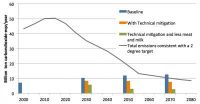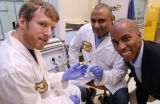(Press-News.org) ANN ARBOR, Mich. — Adolescents with stronger muscles have a lower risk of heart disease and diabetes, according to a new study that examined the influence of muscle strength in sixth grade boys and girls.
Stronger kids also have lower body mass index (weight to height ratio), lower percent body fat, smaller waist circumferences, and higher fitness levels, according to the study that appears in Pediatrics.
Researchers analyzed health data for more than 1,400 children ages 10 to 12, including their percent body fat, glucose level, blood pressure, cholesterol levels and triglycerides (a type of fat, or lipid, which may increase risk of heart disease). Those with greater strength-to-body-mass ratios – or pound-for-pound strength capacities— had significantly lower risks of heart disease and diabetes.
"It's a widely-held belief that BMI, sedentary behaviors and low cardiovascular fitness levels are linked to diabetes, heart disease and stroke, but our findings suggest muscle strength possibly may play an equally important role in cardiometabolic health in children," says lead author Mark D. Peterson, Ph.D, M.S., research assistant professor in the Department of Physical Medicine and Rehabilitation at the University of Michigan Medical School.
The study's corresponding author was Paul M. Gordon, Ph.D., M.P.H, who is a Professor at Baylor University in Texas. Gordon suggests that strengthening activities may be equally important to physical activity participation.
The research is based on data from the Cardiovascular Health Intervention Program (CHIP), a study of sixth graders from 17 mid-area Michigan schools between 2005 and 2008.
Participants were tested for strength capacity using a standardized handgrip strength assessment, which is recently recommended by the Institute of Medicine (IOM). Researchers also measured cardiorespiratory fitness – how well the body is able to transport oxygen to muscles during prolonged exercise, and how well muscles are able to absorb and use it.
The study is one of the the first to show a robust link between strength capacity and a lower chance of having diabetes, heart disease or stroke (cardiometabolic risk) in adolescents, after controlling for the influence of BMI, physical activity participation, and cardiorespiratory fitness.
"The stronger you are relative to your body mass, the healthier you are," Peterson says. "Exercise, sports, and even recreational activity that supports early muscular strength acquisition, should complement traditional weight loss interventions among children and teens in order to reduce risks of serious diseases throughout adolescence."
Previous, large-scale studies have found low muscular strength in teen boys is a risk factor for several major causes of death in young adulthood, such as suicide and cardiovascular diseases.
INFORMATION:
Additional Authors: William A. Saltarelli, Ph.D. of Central Michigan University and Paul S. Visich, Ph.D., M.P.H. of the University of New England.
Funding: Memorial Healthcare Foundation, as part of the Memorial FIT Kids program in Owosso, Mich.
Disclosures: None
Reference: "Strength Capacity and Cardiometabolic Risk Clustering in Adolescents," Pediatrics, March 31, 2014, doi: 10.1542/peds.2013-3169
Brawn matters: Stronger adolescents and teens have less risk of diabetes, heart disease
More muscle health led to better metabolic and heart health for children, says study
2014-03-31
ELSE PRESS RELEASES FROM THIS DATE:
Stats show growth of breast lifts outpacing implants 2-to-1
2014-03-31
VIDEO:
New statistics from the American Society of Plastic Surgeons show that since 2000, breast lift procedures have grown by 70 percent, twice the rate of breast implants. According to the...
Click here for more information.
ARLINGTON HEIGHTS, Ill., March 31, 2014 – New statistics released today by the American Society of Plastic Surgeons (ASPS) show that breast lift procedures are growing at twice the rate of breast implant surgeries. Since 2000, breast lifts have grown by ...
Quality of life for couples can be improved despite PVD (vulvar vestibulitis)
2014-03-31
Spouses who regulate their emotions together in a satisfactory manner are more fulfilled sexually, psychologically, and relationally, among couples in which the woman has provoked vestibulodynia (PVD), also known as "vulvar vestibulitis". This was discovered by Nayla Awada, a doctoral candidate in psychology at the Université de Montréal, in a study which she conducted with 254 couples in which the woman was diagnosed with PVD. PVD is characterized by often chronic pain felt on the "vestibule," or entrance of the vagina, especially during penetration. The pain is usually ...
New gel to promote bone growth on implants used in surgical procedures
2014-03-31
A research group at Uppsala University, Sweden has developed a new responsive coating for implants used in surgery to improve their integration into bone and to prevent rejection. Neutron scattering experiments at the Institut Laue-Langevin (ILL) in Grenoble, France have shown how a protein that promotes bone growth binds to this surface and can be released in a controlled way.
Orthopaedic and dental implants must last for many years. Success for these surgical components depends on integration into adjacent bone tissue. Gels made by modifying hyaluronan, a large biological ...
New study confirms benefits of treating heart attack patients with a cheap drug
2014-03-31
The initial results of this trial were published a few months ago (Circulation. 2013;128:1495-1503), and showed that patients who received this treatment during emergency transit to hospital had much smaller amounts of dead heart muscle than those randomly assigned to receive no treatment. The new study shows that the proportion of patients with a severely deteriorated heart contractile function is much less (60%) in the group that received metoprolol. Early treatment with metoprolol treatment also significantly reduced the rate of hospital readmission for chronic heart ...
Meeting climate targets may require reducing meat and dairy consumption
2014-03-30
Greenhouse gas emissions from food production may threaten the UN climate target of limiting global warming to 2 degrees Celsius, according to research at Chalmers University of Technology, Sweden.
On Monday 31 March the Intergovernmental Panel on Climate Change (IPCC) presents their report on the impacts of climate change.
Carbon dioxide emissions from the energy and transportation sectors currently account for the largest share of climate pollution. However, a study from Chalmers now shows that eliminating these emissions would not guarantee staying below the UN ...
Genetic markers may predict when people with heart disease are likely to have a heart attack
2014-03-30
Researchers at the Intermountain Medical Center Heart Institute in Salt Lake City have identified a biological process that may help physicians predict when someone with heart disease is likely to have a heart attack in the near future.
A new study by the team has identified plasma levels of two markers – microRNA 122 and 126 – that appear to decline a few days before a person suffers a heart attack. Results of the study could help the 715,000 Americans who suffer from heart attacks each year.
"It's always been a mystery trying to identify people with heart disease ...
Researchers uncover secrets of a mollusk's unique bioceramic armor
2014-03-30
CAMBRIDGE, Mass-- The shells of a sea creature, the mollusk Placuna placenta, are not only exceptionally tough, but also clear enough to read through. Now, researchers at MIT have analyzed these shells to determine exactly why they are so resistant to penetration and damage — even though they are 99 percent calcite, a weak, brittle mineral.
The shells' unique properties emerge from a specialized nanostructure that allows optical clarity, as well as efficient energy dissipation and the ability to localize deformation, the researchers found. The results are published this ...
New study finds strong link between obesity and 'carb breakdown' gene
2014-03-30
Researchers at King's College London and Imperial College London have discovered that people with fewer copies of a gene coding for a carb-digesting enzyme may be at higher risk of obesity. The findings, published in Nature Genetics, suggest that dietary advice may need to be more tailored to an individual's digestive system, based on whether they have the genetic predisposition and necessary enzymes to digest different foods.
Salivary amylase plays a significant role in breaking down carbohydrates in the mouth at the start of the digestion process. The new study suggests ...
Earth's dynamic interior
2014-03-30
VIDEO:
This video shows a numerical simulation of Earth's deep mantle. The top panel is temperature and the bottom panel is composition which includes three components: the more-primitive reservoir at the...
Click here for more information.
TEMPE, Ariz. – Seeking to better understand the composition of the lowermost part of Earth's mantle, located nearly 2,900 kilometers (1,800 miles) below the surface, a team of Arizona State University researchers has developed new simulations ...
Heat-conducting polymer cools hot electronic devices at 200 degrees C
2014-03-30
Polymer materials are usually thermal insulators. But by harnessing an electropolymerization process to produce aligned arrays of polymer nanofibers, researchers have developed a thermal interface material able to conduct heat 20 times better than the original polymer. The modified material can reliably operate at temperatures of up to 200 degrees Celsius.
The new thermal interface material could be used to draw heat away from electronic devices in servers, automobiles, high-brightness LEDs and certain mobile devices. The material is fabricated on heat sinks and heat ...
LAST 30 PRESS RELEASES:
Tracing the quick synthesis of an industrially important catalyst
New software sheds light on cancer’s hidden genetic networks
UT Health San Antonio awarded $3 million in CPRIT grants to bolster cancer research and prevention efforts in South Texas
Third symposium spotlights global challenge of new contaminants in China’s fight against pollution
From straw to soil harmony: International team reveals how biochar supercharges carbon-smart farming
Myeloma: How AI is redrawing the map of cancer care
Manhattan E. Charurat, Ph.D., MHS invested as the Homer and Martha Gudelsky Distinguished Professor in Medicine at the University of Maryland School of Medicine
Insilico Medicine’s Pharma.AI Q4 Winter Launch Recap: Revolutionizing drug discovery with cutting-edge AI innovations, accelerating the path to pharmaceutical superintelligence
Nanoplastics have diet-dependent impacts on digestive system health
Brain neuron death occurs throughout life and increases with age, a natural human protein drug may halt neuron death in Alzheimer’s disease
SPIE and CLP announce the recipients of the 2025 Advanced Photonics Young Innovator Award
Lessons from the Caldor Fire’s Christmas Valley ‘Miracle’
Ant societies rose by trading individual protection for collective power
Research reveals how ancient viral DNA shapes early embryonic development
A molecular gatekeeper that controls protein synthesis
New ‘cloaking device’ concept to shield sensitive tech from magnetic fields
Researchers show impact of mountain building and climate change on alpine biodiversity
Study models the transition from Neanderthals to modern humans in Europe
University of Phoenix College of Doctoral Studies releases white paper on AI-driven skilling to reduce burnout and restore worker autonomy
AIs fail at the game of visual “telephone”
The levers for a sustainable food system
Potential changes in US homelessness by ending federal support for housing first programs
Vulnerability of large language models to prompt injection when providing medical advice
Researchers develop new system for high-energy-density, long-life, multi-electron transfer bromine-based flow batteries
Ending federal support for housing first programs could increase U.S. homelessness by 5% in one year, new JAMA study finds
New research uncovers molecular ‘safety switch’ shielding cancers from immune attack
Bacteria resisting viral infection can still sink carbon to ocean floor
Younger biological age may increase depression risk in older women during COVID-19
Bharat Innovates 2026 National Basecamp Showcases India’s Most Promising Deep-Tech Ventures
Here’s what determines whether your income level rises or falls
[Press-News.org] Brawn matters: Stronger adolescents and teens have less risk of diabetes, heart diseaseMore muscle health led to better metabolic and heart health for children, says study




